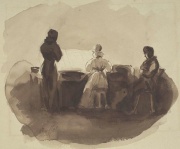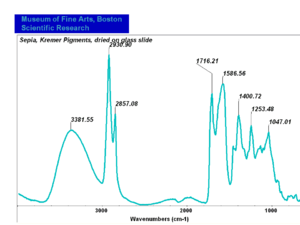Difference between pages "Chromolithograph" and "Sepia"
| Line 1: | Line 1: | ||
| − | [[File: | + | [[File:MFA59795.jpg|thumb|Lithograph of Stonehenge<br>MFA# 59.795]] |
== Description == | == Description == | ||
| − | [[File: | + | [[File:48.375-SC31223.jpg|thumb|Sepia wash<br>MFA# 48.375]] |
| − | + | 1) The dark brown-black liquid secreted by the cuttlefish, ''Sepia officinalis'' or other Cephalopoda. The ink sacs and fluid are removed from the squid and sun-dried; then the color is extracted with alkali and precipitated with acid. Sepia was used for inks since antiquity. It was first introduced as a watercolor pigment mixed with [[gum arabic]] about 1780 by Jacob Seydelmann in Dresden. Sepia is a natural organic acid that is fairly permanent, except in strong sunlight. | |
| − | + | ||
| + | 2) A dark, warm black color resembling the tone obtained from cuttlefish ink. Other pigment mixtures of [[burnt umber]], [[Vandyke brown]], and [[lampblack]] are also sold under the name sepia. | ||
| + | |||
| + | 3) (not common) A powder composed of ground cuttlefish bones. Sepia powder, also called [[sepiolite]], is composed of [[calcium carbonate]] and [[calcium phosphate]]. It is used as a polishing agent. | ||
== Synonyms and Related Terms == | == Synonyms and Related Terms == | ||
| − | + | 1) Warm Black; cuttlefish ink; sepiomelanin; Natural Brown 9; sépia (Fr., Port.) | |
| + | |||
| + | 3) cuttlefish bone; cuttlebone; sepiolite; | ||
| + | |||
| + | [[[SliderGallery rightalign|Sepia, Kremer Pigments.PNG~FTIR (MFA)]]] | ||
| + | |||
| + | == Physical and Chemical Properties == | ||
| + | |||
| + | * Soluble in ammonium hydroxide, alkalis. Insoluble in acids, water, ethanol. | ||
| + | * Decolorized by nitric acid and chlorine bleaches. | ||
| + | * Fishy odor. | ||
| + | * Fugitive in ultraviolet light. | ||
| + | |||
| + | == Resources and Citations == | ||
| + | |||
| + | * R. J. Gettens, G.L. Stout, ''Painting Materials, A Short Encyclopaedia'', Dover Publications, New York, 1966 | ||
| + | |||
| + | * Helmut Schweppe, Schweppe color collection index and information book | ||
| + | |||
| + | * G.S.Brady, ''Materials Handbook'', McGraw-Hill Book Co., New York, 1971 Comment: p. 609 | ||
| + | |||
| + | * Reed Kay, ''The Painter's Guide To Studio Methods and Materials'', Prentice-Hall, Inc., Englewood Cliffs, NJ, 1983 | ||
| + | |||
| + | * Ralph Mayer, ''A Dictionary of Art Terms and Techniques'', Harper and Row Publishers, New York, 1969 (also 1945 printing) | ||
| + | |||
| + | * Richard S. Lewis, ''Hawley's Condensed Chemical Dictionary'', Van Nostrand Reinhold, New York, 10th ed., 1993 | ||
| + | |||
| + | * Hermann Kuhn, ''Conservation and Restoration of Works of Art and Antiquities'', Butterworths, London, 1986 | ||
| − | + | * R.D. Harley, ''Artists' Pigments c. 1600-1835'', Butterworth Scientific, London, 1982 | |
| − | * '' | + | * Matt Roberts, Don Etherington, ''Bookbinding and the Conservation of Books: a Dictionary of Descriptive Terminology'', U.S. Government Printing Office, Washington DC, 1982 |
| − | * | + | * Random House, ''Webster's Encyclopedic Unabridged Dictionary of the English Language'', Grammercy Book, New York, 1997 |
| − | * ''The | + | * ''The Merck Index'', Martha Windholz (ed.), Merck Research Labs, Rahway NJ, 10th edition, 1983 Comment: entry 8601 |
| − | * | + | * ''The American Heritage Dictionary'' or ''Encarta'', via Microsoft Bookshelf 98, Microsoft Corp., 1998 |
| − | * | + | * ''Encyclopedia Britannica'', http://www.britannica.com Comment: "sepia." (Accessed 7 Apr. 2005). |
| − | * | + | * ''The Dictionary of Art'', Grove's Dictionaries Inc., New York, 1996 Comment: 'Pigment' |
[[Category:Materials database]] | [[Category:Materials database]] | ||
Latest revision as of 14:05, 30 May 2022
Description
1) The dark brown-black liquid secreted by the cuttlefish, Sepia officinalis or other Cephalopoda. The ink sacs and fluid are removed from the squid and sun-dried; then the color is extracted with alkali and precipitated with acid. Sepia was used for inks since antiquity. It was first introduced as a watercolor pigment mixed with Gum arabic about 1780 by Jacob Seydelmann in Dresden. Sepia is a natural organic acid that is fairly permanent, except in strong sunlight.
2) A dark, warm black color resembling the tone obtained from cuttlefish ink. Other pigment mixtures of Burnt umber, Vandyke brown, and Lampblack are also sold under the name sepia.
3) (not common) A powder composed of ground cuttlefish bones. Sepia powder, also called Sepiolite, is composed of Calcium carbonate and Calcium phosphate. It is used as a polishing agent.
Synonyms and Related Terms
1) Warm Black; cuttlefish ink; sepiomelanin; Natural Brown 9; sépia (Fr., Port.)
3) cuttlefish bone; cuttlebone; sepiolite;
Physical and Chemical Properties
- Soluble in ammonium hydroxide, alkalis. Insoluble in acids, water, ethanol.
- Decolorized by nitric acid and chlorine bleaches.
- Fishy odor.
- Fugitive in ultraviolet light.
Resources and Citations
- R. J. Gettens, G.L. Stout, Painting Materials, A Short Encyclopaedia, Dover Publications, New York, 1966
- Helmut Schweppe, Schweppe color collection index and information book
- G.S.Brady, Materials Handbook, McGraw-Hill Book Co., New York, 1971 Comment: p. 609
- Reed Kay, The Painter's Guide To Studio Methods and Materials, Prentice-Hall, Inc., Englewood Cliffs, NJ, 1983
- Ralph Mayer, A Dictionary of Art Terms and Techniques, Harper and Row Publishers, New York, 1969 (also 1945 printing)
- Richard S. Lewis, Hawley's Condensed Chemical Dictionary, Van Nostrand Reinhold, New York, 10th ed., 1993
- Hermann Kuhn, Conservation and Restoration of Works of Art and Antiquities, Butterworths, London, 1986
- R.D. Harley, Artists' Pigments c. 1600-1835, Butterworth Scientific, London, 1982
- Matt Roberts, Don Etherington, Bookbinding and the Conservation of Books: a Dictionary of Descriptive Terminology, U.S. Government Printing Office, Washington DC, 1982
- Random House, Webster's Encyclopedic Unabridged Dictionary of the English Language, Grammercy Book, New York, 1997
- The Merck Index, Martha Windholz (ed.), Merck Research Labs, Rahway NJ, 10th edition, 1983 Comment: entry 8601
- The American Heritage Dictionary or Encarta, via Microsoft Bookshelf 98, Microsoft Corp., 1998
- Encyclopedia Britannica, http://www.britannica.com Comment: "sepia." (Accessed 7 Apr. 2005).
- The Dictionary of Art, Grove's Dictionaries Inc., New York, 1996 Comment: 'Pigment'


